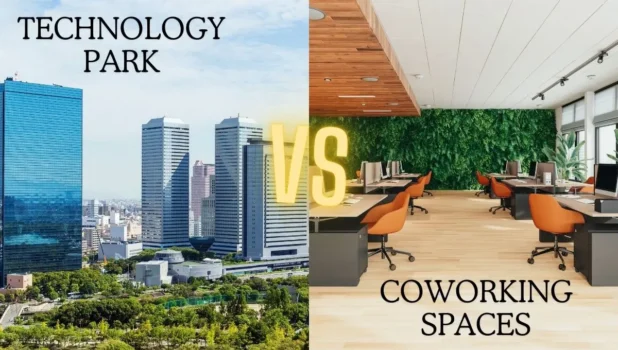In today’s fast-evolving business landscape, the choice between technology parks and coworking spaces is crucial for startups, freelancers, and established companies alike. This article delves into the core differences, benefits, and drawbacks of each, providing insights to help businesses make informed decisions.
Understanding Technology Parks
Technology parks, often synonymous with science parks or innovation centers, are designed to spur regional development through innovation, research, and development facilities. These hubs typically cater to tech startups, larger enterprises, and academic institutions, fostering a close-knit community focused on technological advancements. The infrastructure in technology parks supports high-tech infrastructure, including state-of-the-art labs, high-speed internet, and advanced research facilities.

Find Your Ideal Workspace: Technology Parks vs. Coworking Spaces
| Technology Parks | Coworking spaces |
| Tech Parks: Structure, Corporate, All the Resources | Coworking: Buzz, Community, Flexibility is King |
| Big campuses, labs, high-security, on-site everything | A mix of workspaces, essentials + collaboration areas, city locations |
| Established players, scaling up, needing the complete package | Flexible plans, meet people and work your way. |
| Big spaces, serious tech, company-focused. | You’re starting, want connections, and save money. |
| You’re established and need lots of resources. | Think Community Hub. Flexible workspaces focus on networking and shared resources. |
| Think Corporate campus: expansive spaces, labs, and high-tech infrastructure. | Best for Startups, freelancers, and those who want a dynamic setting and cost-effective solutions. |
| Best for: Established businesses needing extensive resources and a structured environment. |
On the flip side, coworking spaces—also referred to as shared offices or flex spaces—offer a more flexible office environment. These spaces are popular among freelancers, remote workers, and entrepreneurs who seek a dynamic working environment. Coworking spaces are known for their emphasis on collaboration and networking, providing a platform for like-minded professionals to connect and collaborate.
While both environments offer professional workspaces, technology parks often boast larger, more permanent facilities tailored to specific scientific and technological research needs. These parks might include specialized labs and equipment unavailable in typical coworking setups. In contrast, coworking spaces excel in providing versatile workspaces that include hot desks, private offices, and open-plan environments, complemented by amenities like conference rooms and on-site cafes.
One of the critical distinctions between technology parks and coworking spaces lies in their cost structure. Technology parks often require a significant investment in infrastructure and long-term lease agreements, reflecting their focus on long-term development and larger entities. Conversely, coworking spaces offer more affordable workspace options with flexible membership fees, catering to individuals and small teams with limited budgets.
Choosing the Right Environment for Your BusinessDeciding between a technology park and a coworking space depends largely on your business needs, industry, and growth stage. For tech companies and startups focused on R&D, a technology park might be the better option due to its specialized facilities and resources. Freelancers, small startups, and companies with flexible work practices may find coworking spaces more appealing for their affordability and networking opportunities.
The Future of WorkspacesAs the business world continues to evolve, the lines between technology parks and coworking spaces may blur, with new hybrid models emerging that combine the best aspects of both. These future workspaces might offer the flexibility and community of coworking with the specialized resources of technology parks, accommodating the diverse needs of the modern workforce.
Conclusion
Both technology parks and coworking spaces offer unique advantages and can significantly impact business growth and operational efficiency. By understanding the key features and differences of each, companies can choose the environment that best suits their immediate and future needs, fostering growth and innovation in their respective fields.






